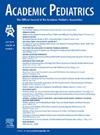Illustrating the Role of Infant Well-Child Visits in the Association Between Transportation Insecurity and Acute Health Care Use
IF 2.8
3区 医学
Q1 PEDIATRICS
引用次数: 0
Abstract
Objective
To evaluate the role of well-child visits (WCVs) in mediating associations between transportation insecurity and acute health care usage among infants.
Methods
This was a retrospective cohort study of 4114 infants seen for newborn visits at 3 primary care centers between February 1, 2019 and March 31, 2021. Each infant was followed through 15 months of age. The outcome of interest was acute health care usage, defined by high-acuity emergency department (ED) visits or hospitalization. The exposure was transportation insecurity as reported by parents through standardized questionnaires administered during WCVs. We stratified analyses by WCV attendance (≥6 WCVs vs <6 WCVs in the first 15 months of life) to assess whether WCVs mediated associations between acute health care usage and transportation insecurity.
Results
Of 4114 eligible infants, 8.7% endorsed transportation insecurity. Patients reporting transportation insecurity, compared to those who did not, had higher rates of incomplete WCV attendance (60.3% vs 44.2%, P < 0.001), ED visitation (38.0% vs 28.7%; P < 0.001), and hospitalization (19.8% vs 14.1%; P = 0.004). Transportation insecurity, compared to no transportation security, was significantly associated with having <6 WCVs (adjusted odds ratio [aOR] 1.64, 95% confidence interval [CI] 1.29, 2.09), ED visitation (aOR 1.45, 95% CI 1.14, 1.85), and hospitalization (aOR 1.52, 95% CI 1.13, 2.04). However, WCV attendance did not mediate associations between transportation insecurity and ED visits or hospitalizations.
Conclusions
Transportation insecurity was associated with fewer WCVs; however, WCV attendance did not mediate associations between acute health care usage and transportation insecurity. Future research could focus on mechanisms linking transportation insecurity to suboptimal health outcomes.
说明婴儿和儿童访问在交通不安全和急性医疗保健使用之间的关联中的作用。
目的评估儿童健康检查(WCV)在调解交通不便与婴儿急性期医疗保健使用之间的关联方面所起的作用:这是一项回顾性队列研究,研究对象是 2019 年 2 月 1 日至 2021 年 3 月 31 日期间在三家初级保健中心接受新生儿访视的 4114 名婴儿。对每个婴儿的跟踪调查持续到 15 个月大。研究结果的关注点是急性医疗服务的使用情况,即高危急诊室就诊或住院情况。风险暴露是指父母通过在 WCV 期间进行的标准化问卷调查所报告的交通不安全问题。我们按照参加 WCV 的次数进行了分层分析(≥6 次 WCV 与≥6 次 WCV):在 4,114 名符合条件的婴儿中,8.7% 的婴儿表示交通不便。与未报告交通不便的患者相比,报告交通不便的患者未完成WCV就诊的比例更高(60.3% vs. 44.2%,p结论:交通不安全与WCV就诊次数较少有关;但是,WCV就诊次数并不能调节急性期医疗使用与交通不安全之间的关联。未来的研究可重点关注交通不安全与次优健康结果之间的关联机制。
本文章由计算机程序翻译,如有差异,请以英文原文为准。
求助全文
约1分钟内获得全文
求助全文
来源期刊

Academic Pediatrics
PEDIATRICS-
CiteScore
4.60
自引率
12.90%
发文量
300
审稿时长
60 days
期刊介绍:
Academic Pediatrics, the official journal of the Academic Pediatric Association, is a peer-reviewed publication whose purpose is to strengthen the research and educational base of academic general pediatrics. The journal provides leadership in pediatric education, research, patient care and advocacy. Content areas include pediatric education, emergency medicine, injury, abuse, behavioral pediatrics, holistic medicine, child health services and health policy,and the environment. The journal provides an active forum for the presentation of pediatric educational research in diverse settings, involving medical students, residents, fellows, and practicing professionals. The journal also emphasizes important research relating to the quality of child health care, health care policy, and the organization of child health services. It also includes systematic reviews of primary care interventions and important methodologic papers to aid research in child health and education.
 求助内容:
求助内容: 应助结果提醒方式:
应助结果提醒方式:


